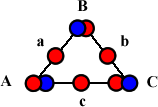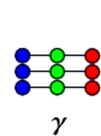Dr. Randell Mills is at odds with the Legacy System of Theory (LST) community over its concept of the electron and the atom. Randy has his own theory of these physical entities, which has placed him smack dab in the middle of the cold fusion controversy, the free-energy controversy, and the interpretation of quantum mechanics controversy.
He disavows the first, he explains that the second is misunderstood, but he takes the third controversy head-on. He has a new replacement theory, based on a reconsideration of the postulates of traditional quantum mechanics, which he claims “has given rise to a closed form solution of a Schrodinger-like wave equation, based on first principles.”
In general, his contention is that traditional QM is mathematical, not physical, and that’s why the physical interpretation is so mysterious. He asserts that all the trouble stems from the assumption of the boundary condition of the Schrodinger equation, which assumes that “the wavefunction goes to zero as the radius goes to infinity.” In his theory, “an extended distribution of charge may accelerate without radiating energy.”
Unlike Larson, however, he produces a prodigious mountain of mathematics to accomplish his work, which is impressively comprehensive. He writes:
From two basic equations, the key building blocks of organic chemistry have been solved, allowing the true physical structure, charge distribution, and parameters of an infinite number of organic molecules of boundless extent and complexity to be obtained including proteins, RNA, and DNA. These equations were also applied to other major fields of chemistry, fundamental forms of matter, bonding, and behavior such as the allotropes of carbon, the solid bond of silicon and the semiconductor bond, the ionic bond, the metallic bond, bonding in condensed matter such as dipole-dipole, hydrogen, and van der Waals bonds, bonding of silicon, tin, aluminum, boron, organometallics, coordinate compounds, and other classes of compounds and materials, reaction kinetics, and thermodynamics.
Also like Larson, he doesn’t stop there at the microcosm, but is audacious enough to go on to treat cosmology, as well:
Further, the Schwarzschild Metric is derived by applying Maxwell’s Equations to electromagnetic and gravitational fields at particle production. This modifies General Relativity to include conservation of spacetime and gives the origin of gravity, the masses of fundamental particles, the acceleration of the expansion of the universe (predicted by Dr. Mills in 1995 and since confirmed experimentally), and overturns the Big Bang model of the origin of the universe.
Quite impressive stuff, indeed. Yet, the LST community is not exactly beating a path to his door. He is not invited to speak at their theoretical conferences, or awarded any of their prestigious prizes, primarily because his theory justifies a form of hydrogen the energy of which is claimed to be a fraction of the known “ground state” of hydrogen, which makes him a pariah among the professionals.
According to traditional QM theory, these fractional states of hydrogen, dubbed “hydrinos,” by Mills, cannot exist, and therefore modern physicists in the LST community criticize Mills’ work and reject the physical evidence he presents, even though it is claimed to have been confirmed by independent investigations.
The fact that Mills has been trying to patent and commercialize the production of hydrinos, since the late Twentieth Century, doesn’t help matters, though. To be fair, however, the establishment actively resisted his patent efforts politically, attempting to have his patents denied, based on scientific, if not economic and thus political bias, delaying his success for eleven years.
Indeed, I’m surprised that the man is still alive, given the iconoclastic nature of his ideas and the incredible social impact of their potential, if brought to fruition. That’s because producing energy from hydrino technology would not only make it possible to dramatically reduce energy costs across the board, making it so inexpensive and ubiquitous that it ceases to be a significant factor in the course of human affairs, destroying oil-based economies in the process, but it would also revolutionize physical theory, destroying QM-based acacemia and research institutions, that depend upon the mystery of QM to maintain the funding of their aloof fiefdoms.
Yet, in spite of all the opposition, Mills may be on the verge of triumph. He demonstrated the key components of his technology last July and reportedly demoed a prototype “SunCell” to investors, raising $16 million dollars in production funding, in September, as a result. Now the world is waiting with bated breath, as 2015 gets underway.
In the meantime, I was curious to understand how the LRC model of hydrinos would fare. It didn’t take long to discover that it fares well, although it may take some courage to publish it. It’s easy to see that our preon model of the electron and the photon allows for increasing the energy of the hydrogen atom from the ground state to an excited state, by absorbtion of photons:
 +
+  =
= 
When the electron absorbs the photon, the S|T unbalance (qualitatively indicated by the color at the nodes a, b and c, in the figure above) is not affected. Thus, no change in the “charge” of the electron, going from ground state (1/2, red), to an excited state (1/2 + 1/1 = 2/3, red) is realized, even though the actual number of the S|T units in the ratio is doubled, by the event.
However, going to a lower state, a fraction of the ground state, is not so easy, since obviously it can’t be done by adding S|T balanced units of the photons (S|T = 1/1, green) to the unbalanced S|T units of the electron (S|T = 1/2, red), as happens in the excited state transitions.
In Mills theory, the electron gives up energy from its central field to a catalyst, through a “non-radiative” process of energy transfer, more like a potential - kinetic energy exchange, which, of course, he must do, in a theory formed within the Newtonian system of theory, based on the vectorial motion of classical physics.
The LRC model, however, has no recourse to such motion, since our model is strictly based on the scalar motion of the Reciprocal System of Physical Theory (RST). Consequently, we are forced to add the unbalanced units of another boson to the electron, the W- boson, in order to “lower” the energy of the hydrogen-bound electron by some “fraction,” and form a hydrino.
Certainly, this is going to be problematic, since the W- boson incorporated into the standard model is so short lived, it can only be presumed to exist. Nevertheless, in our RST-based model, it is a combination of S|T units that must exist, because it is one of the 20 possible combinations of S|T units (16 fermions and 4 bosons). Whether it is short lived or not, would depend on the environment in which it finds itself.
Nevertheless, combining this boson with an electron bound in an hydrogen atom, in our toy model, is as straightforward as combining such an electron with a photon boson:
 +
+  =
= 
But now, by this process, the unbalanced S|T ratio (charge) doubles! It goes from S|T = 1/2 to S|T = (1/2 + 1/2) = 2/4. Therefore, the electron charge changes from -1 to -2, and the electron’s orbit moves closer to the nucleus (in the LST model), by a fraction (1/2) energy-wise in the new hydrino state.
Now, this may still take place “non-radiatively,” if there is an equivalent phonon vibration in the catalyst equivalent to the W- boson. In other words, it may be a kinetic - potential energy exchange just as Mills theory requires.
Well, I wrote to Mills and we have had a few short discussions about it, but, understandably, he is in no position to comprehend the LRC’s RST-based model, and so remains unconvinced, seeing it as numerology. I imagine that only empirical evidence would be convincing enough to get him to consider it, but his people are not looking to see a change in e-, so it’s not likely to be discovered, by them, if it actually exists.
The exciting thing for us, though, is that this just might prove to be a prediction of the LRC’s RST-based model of scalar motion combinations.
Wow.
Update: March 13, 2015